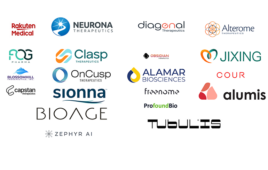
[Sakkmesterke/Adobe Stock]
Now, AQBioSim aims to streamline the research and development process with quantum-inspired computing, potentially contributing to the development of treatments for critical diseases, such as cancer, Alzheimer’s and Parkinson’s. The company says its technology could shave years off the discovery process. In “AQ,” the “A” represents “AI,” while the “Q” denotes “quantum” principles.
Earlier this year, SandboxAQ raised $500 million in funding, aiming to equip businesses with the necessary tools for the eventual arrival of commercial-scale quantum computing. At present, SandboxAQ is more focused on quantum-inspired computing, which uses quantum principles but operates on traditional, classical computing hardware. That is, the company integrates artificial intelligence (AI) and quantum principles using classical computing hardware.
Out of the gate, SandboxAQ has forged pacts with prominent biopharma organizations such as AstraZeneca, Sanofi and University of California, San Francisco (UCSF), all of which are exploring AQBioSim’s technology for drug discovery processes.
Harnessing quantum concepts for drug discovery
Remarks on the need for innovation in drug discovery have come from notable figures in the field, including Dr. Stanley B. Prusiner, Nobel Laureate and the director of UCSF’s Institute for Neurodegenerative Diseases. Addressing the complexities of neurodegenerative diseases, Prusiner highlighted the importance of “rational and structure-based design methods” to address these challenging diseases. Acknowledging the devastating nature of such conditions and the current lack of effective therapies, Prusiner emphasized the need for novel technologies that can accelerate the discovery process.
With a strong focus on AI, Sanofi’s CEO, Paul Hudson, also expressed interest in SandboxAQ’s potential to expedite drug discovery. “SandboxAQ’s leapfrog technology could significantly impact both preclinical and clinical development of drugs, potentially supporting us in delivering life-changing treatments to patients worldwide, faster,” Hudson said.
Dr. Klaus Klumpp, co-founder and president of the biotech Riboscience, quantified the technology’s potential impact. He noted that SandboxAQ’s large-scale Absolute Free Energy Perturbation technology has accelerated their virtual screening campaign execution, allowing them to profile in-silico more than 20,000 ligands per day. This testament to the speed and efficiency of SandboxAQ’s technology reinforces its promising potential in expediting drug discovery.
Despite the promising potential of AQBioSim, SandboxAQ acknowledges the ambitious and complex nature of their objectives. “In the future, we envision being able to routinely tackle complex calculations where, for example, the combinations exceed the number of atoms in the universe,” Harhen said. “This is common in drug discovery where the complexity of chemical space is immense. Brute force computation of all combinations is impossible so we are developing state-of-the-art algorithms that traverse this multidimensional space in efficient ways, allowing us to greatly expand the number of potential drug molecules that can be tested in-silico. To do this, we leverage new algorithmic approaches that efficiently exploit cutting-edge computational hardware.”
Quantum principles on classical hardware
At present, SandboxAQ’s approach can best be described as a hybrid one: they apply AI and quantum principles using classical computing hardware to address longstanding challenges in drug discovery and other fields.

Nadia Harhen
“So everything we do on our side is mostly on GPUs and TPUs. We bring that background from Google,” Harhen said. “So Google, obviously has a Quantum Computing group, yes, but also massive expertise in scalability for GPUs in particular, which is like where we got our expertise coming out of X Moonshot factory,” she added.
SandboxAQ provides operational definitions and measures. For instance, SandboxAQ’s Absolute Free Energy Perturbation (AQ-FEP) software enables researchers to generate thousands of predictions at unprecedented speed and accuracy. The company notes that the software can decrease the time and cost of developing new therapies and the ability to de-risk drug portfolios before entering preclinical and clinical stages.
Maximizing the power of GPUs and TPUs in quantum-inspired drug discovery
SandboxAQ’s approach is tailored to GPUs, drawing from Google’s strong background in scalable GPU technologies and quantum computing. This approach enables the company to handle highly complex tasks such as analyzing a COVID protein spike – a significant computational challenge.
A cornerstone of SandboxAQ’s approach is the AQ FEP method, an innovative blend of artificial intelligence, quantum principles and classical computing. Harhen emphasizes this is not only unique but it also sets SandboxAQ apart in its field. This method is pivotal in conducting Free Energy Perturbation (FEP) calculations efficiently and at a scale previously unthinkable. As Harhen put it, “Speed in drug discovery is essential, as it connects to the development in a way that reduces risks in clinical trials. The aim is to identify potential failures earlier than phase 2.”
Further explaining the company’s proprietary methods, Harhen reveals that these techniques, including AQ FEP, allow for screening tens of thousands of ligands daily, enabling machine learning modeling and active learning of libraries. “Based on benchmarking studies with commonly used screening libraries, our proprietary methods are routinely over 24x faster than commonly used solutions,” Harhen said. This impressive speed makes it possible to screen larger compound sets and helps avoid the situation where promising candidates are missed as a result of limited resources.
In addition to speed, accuracy also plays a crucial role in SandboxAQ’s approach. Harhen notes, “The accuracy of our AQ FEP method over traditional docking approaches provides the ability to recover false negatives from initial screens,” thereby ensuring no potential candidates are overlooked.
An educational and promotional video by the company features General Manager Nadia Harhen and Technical Lead Adam Lewis discussing the potential of quantum simulations in the development of new drugs.
Density functional theory: A world record
SandboxAQ’s power lies in its mastery of Density Functional Theory (DFT) calculations. These resource-intensive computations are essential for investigating the electronic structure of many-body systems like atoms, molecules and solid materials. SandboxAQ’s world record in DFT calculations signifies its ability to handle highly intricate quantum mechanical simulations on classical hardware, marking a notable accomplishment in computational chemistry. “This world record in DFT calculations represents a significant achievement in computational chemistry. We have applied this breakthrough to impact drug discovery positively,” Harhen stated.
Quantum computing brings both opportunities and challenges for SandboxAQ. Though we are in the quantum era, it remains early. SandboxAQ aims for “quantum advantage,” when quantum computers solve complex problems beyond classical computers. While predominately using quantum methods on classical computers now, SandboxAQ closely follows progress toward this milestone.
The noisy intermediate-scale quantum era
Harhen highlights the practical difficulties in maintaining stable quantum states, pointing out that ‘Disturbances in the superposition of qubits—a fundamental quantum computing concept where a qubit can exist in multiple states at once—can render them ineffective for calculations.’ However, she acknowledges that “Many researchers in the industry are working on these challenges, but it can be difficult to differentiate hype from reality. Nevertheless, we believe in the potential of quantum computing and its capacity to enable companies to progressively adopt the technology. As computational power increases, it will enable even larger, more powerful calculations.”
Regarding the company’s focus, Harhen explained, “At Sandbox, our attention is not so much on quantum computers themselves but rather on the NISQ stage,” she said, referring to the Noisy Intermediate-Scale Quantum period. This is a transitional phase when fully-functional quantum computers do not yet exist, and our available quantum systems are of intermediate-scale and noisy, meaning error-prone. During this time, we are focused on developing robust qubits, the fundamental units of quantum information, that can consistently deliver accurate results despite the inherent noise. “During this era, we are focused on developing robust qubits, the fundamental units of quantum information, that can deliver accurate results consistently despite the inherent noise,” she said.
Several companies, such as Merck KGaA, Darmstadt, Germany and Novo Nordisk, have already recognized the potential of quantum computing and are investing in it, adopting diversified strategies that involve traditional drug discovery, tools that bridge classical hardware and quantum computers, and direct investments in quantum computing itself. SandboxAQ, however, operates in this intermediary space, potentially providing an advantage to early adopters of the technology.
Farther out: Beyond quantum-inspired drug discovery
Reaching the potential benchmark of quantum advantage could be a game changer for various fields, including drug discovery, environmental sciences and personalized medicine. Commercial-scale quantum computing, should it become viable and accessible, may possibly be available through the cloud. As Harhen projected, “everything could be accessible via the cloud,” suggesting a possible fundamental shift for the pharma industry, which has traditionally embraced the cloud more tentatively than many other sectors.
This notion of cloud-based quantum computing brings with it a slew of other considerations, notably cybersecurity. As Nadia reflects, “it’s interesting because one of the other areas of our business is the cybersecurity component. So these two domains have to really work hand in hand, or else your intellectual property is constantly being exploited.”
According to a Harvard Business Review article, while quantum computing remains in a prototype phase, the eventual adoption of the technology could reshape domains ranging from genomics to new materials development. To navigate this emergent field, some companies are exploring hybrid approaches that combine quantum-inspired algorithms and models with traditional computing to bridge the gap to the future of quantum computing.
Navigating the challenges and possibilities of quantum computing applications
Addressing this transition and the challenges that come with it, Harhen says, “There’s so much we can do right now, but it’s hard to tell companies what to focus on.” The potential of quantum computing is vast, yet pinpointing its most effective application remains a challenge.
She suggests environmental sciences and personalized medicine as potential areas where quantum computing could have significant impacts. “Personalized medicine can really go a long way with quantum computers. By analyzing large-scale genomic data it would be possible to identify specific genetic variations and interactions relevant to individual patients, enabling precision medicine,” explains Harhen. “We’ve been unable to do these types of things because we have to break the problem down into so many different parts, and the data is too fragmented to start that we can’t effectively arrive at the resolution we need.”
Harhen contemplates the potential magnitude of the quantum computing impact, stating, “If it all lines up, I think it could be very transformative.” She sees potential in quantum computing’s ability to solve complex problems like understanding the crystal structures of drugs and how they can be delivered effectively. Yet she acknowledges that the path to identifying repeatable and scalable use cases is a process of exploration itself. Commercial payoffs are unlikely to be immediate, but “If it all lines up, I think it could be very transformative,” Harhen concluded.
Filed Under: Drug Discovery and Development, Genomics/Proteomics, Industry 4.0, machine learning and AI



